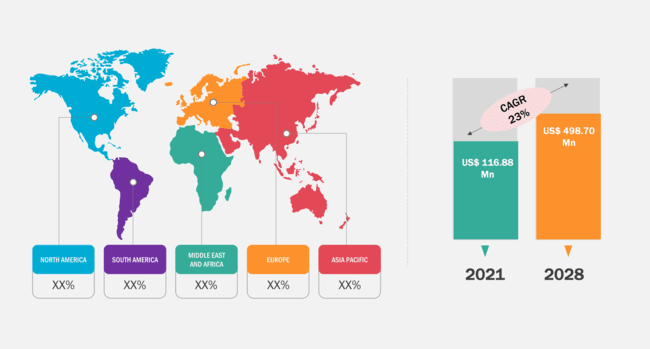The human augmentation market size is expected to reach US$ 498.70 Billion by 2028; registering at a CAGR of 23.0% from 2022 to 2028, according to a new research study conducted by The Insight Partners.
Technological Advancements in the Field of Engineering, Neuroscience, and Biotechnology Boost Human Augmentation Market Growth
Human Augmentation Market Size and Forecasts (2021 - 2031), Global and Regional Share, Trends, and Growth Opportunity Analysis Report Coverage: - by Product Type (Wearable Devices, Virtual Reality Devices, Augmented Reality Devices, Exoskeleton, and Intelligent Virtual Assistants), Functionality (Body Worn and Non-body Worn), Application (Consumer, Commercial, Healthcare, Aerospace and Defense, Energy and Utility, and Others), and Geography (North America, Europe, Asia Pacific, and South and Central America)
Human Augmentation Market Trends and Forecast (2021-2031)
Download Free Sample
Human augmentation is the technology that aims at boosting human ability and efficiency through various artificial methods. It integrates biotechnology and machines that are used for improving the required human skills with the help of artificial or natural methods. Human augmentation has experienced huge adoption in various industries, such as military, defense, healthcare, and manufacturing organizations. The rising demand for human augmentation devices, such as AR devices, VR devices, exoskeletons, etc., has encouraged developers to launch advanced products, which is anticipated to propel the human augmentation market growth in the coming years. Further, the development in the healthcare sector is the major factor contributing to the growth of the human augmentation market. However, the lack of skilled employees and the high cost of medical apparatus are limiting the growth of the market.
Human augmentation helps individuals reduce physical stress and restore psychological and physical abilities. Further, various technological advancements in the field of engineering, neuroscience, and biotechnology have initiated physical and cognitive improvements in the quality of life and health of human beings. The inclination of people toward advanced technologies has led to the growth of the healthcare sector. For instance, in September 2021, B-Temia Inc. launched a new version of Keeogo, one of its flagship products. The new version of Keeogo (smart-powered orthosis) is designed to enhance the experience of clinicians and end-users. Further, in the healthcare sector, prosthetic limbs/arms (a form of exoskeleton) are provided to disabled people, which helps them in performing day-to-day tasks. Similarly, a wide variety of exoskeletons are present in the market, which helps individuals or the aged population with joint/limb disabilities to manuever easily. Another example of a human augmentation device used in the healthcare sector is a capsule camera, a swallowing device designed for visually examining the digestive tract.
One of the key trends in the human augmentation market is the development of technologies that can be used to enhance the functions of the human body without the need for any implants or surgery. For instance, the development of exoskeletons improves the strength and endurance of the body and enhances the function of the brain, such as brain-computer interfaces. A few of the associations associated to the human augmentation market are VR/AR Association (VRARA), Association of the Exoskeleton Industry (VDEI), Australian Orthotic Prosthetic Association Ltd. (AOPA), International Virtual Assistants Association (IVAA), Canadian Association of Virtual Assistants (CAVA), International Association of Professional Virtual Assistants (IAPO), etc.
Google Inc.; Samsung Electronics Co. Ltd.; Ekso Bionics Holdings, Inc.; Vuzix Corporation; Garmin; Fossil Group, Inc.; B-Temia Inc.; Casio, Magic Leap Inc.; and Rewalk Robotics Ltd. are a few of the key human augmentation market players profiled in the report. Several other major companies, such as Panasonic Corporation, Toyota Motor Corporation, Parker Hannifin, and Cyberdyne, were also studied and analyzed during this research study to get a holistic view of the human augmentation market and its ecosystem. Many market players in the human augmentation market are following organic and inorganic growth strategies, such as product launches, product developments, market expansion, partnerships, collaborations, and mergers and acquisitions, to remain competitive in the market. A few of the examples are mentioned below:
- In September 2021, Fossil launched its Gen 6 touchscreen smartwatch line in a virtual press conference. A few of its features include:
- Offers quick customers application load times
- Responsive user experiences
- Efficient power consumption
- It is powered by the Qualcomm Snapdragon Wear 4100+ Platform
- In May 2021, Ekso Bionics extended its partnership with Kindred Healthcare, a post-acute healthcare services company, to bring EksoNR (clinically used robotic exoskeleton) to four of Kindred's Long-Term Acute Care Hospitals in the US.
- In June 2021, Magic Leap partnered with AMD, an American multinational semiconductor company, to utilize Nvidia graphics acceleration technology for its first AR/XR headset.
- In January 2021, Google LLC acquired Fitbit Inc. for US$ 2.1 billion for entering the wearable payment device market.
- In September 2020, Vuzix Corporation launched Blade, a glass featuring Vuzix’s new waveguide technology. Waveguides merge instructions that are sent digitally into real tasks and help in the removal of visual distractions and occlusion. The smart glasses also feature autoscan cameras and noise cancellation.
Contact Us
Phone: +1-646-491-9876
Email Id: sales@theinsightpartners.com